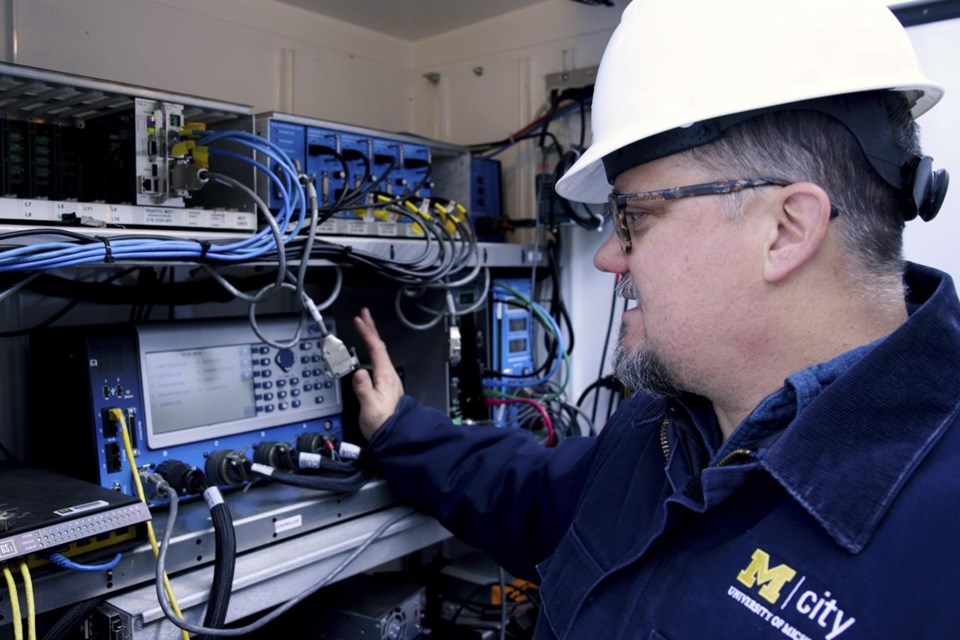As cars and trucks get smarter and more connected, the humble lights that have controlled the flow of traffic for more than a century could also be on the cusp of a major transformation.
Researchers are exploring ways to use features in modern cars, such as GPS, to make traffic safer and more efficient. Eventually, the upgrades could do away entirely with the red, yellow and green lights of today, ceding control to driverless cars.
Henry Liu, a civil engineering professor who is leading a study through the University of Michigan, said the rollout of a new traffic signal system could be a lot closer than people realize.
“The pace of artificial intelligence progress is very fast, and I think it’s coming,” he said.
Traffic lights haven’t changed much in the U.S. over the years. Cleveland debuted what is considered the first “municipal traffic control system” in 1914, historian Megan Kate Nelson wrote for Smithsonian Magazine. Powered by the electricity from the city’s trolley line, engineer James Hodge’s invention featured two lights: red and green, the colors long used by railroads. A police officer sitting in a booth on the sidewalk had to flip a switch to change the signal.
A few years later, Detroit police officer William Potts is credited with adding the yellow light, though as a city employee he couldn’t patent it. By 1930, Nelson wrote, all major American cities and many smaller ones had at least one electrical traffic signal.
The advent of connected and automated vehicles, though, has presented a world of new possibilities for traffic signals.
Among those reimagining traffic flows is a team at North Carolina State University led by Ali Hajbabaie, an associate engineering professor. Rather than doing away with today's traffic signals, Hajbabaie suggests adding a fourth light, perhaps a white one, to indicate when there are enough autonomous vehicles on the road to take charge and lead the way.
“When we get to the intersection, we stop if it's red and we go if it's green," said Hajbabaie, whose team used model cars small enough to hold. “But if the white light is active, you just follow the vehicle in front of you.”
Although Hajbabaie's research refers to a “white phase” and possibly even a white light, the specific color isn’t important, he said. Current lights could even suffice, say, by modifying them to flash red and green simultaneously to signal that driverless cars are in charge. The key would be making sure that it's universally adopted like the current signals are.
Using such an approach would be years away, as it would require 40% to 50% of vehicles on the road to be self-driving in order to work, Hajbabaie acknowledged.
Waymo spokesperson Sandy Karp pointed out that the self-driving car subsidiary of Google's parent company launched a fully autonomous ride-sharing service in Los Angeles and Austin, Texas, even without the addition of a fourth traffic light.
“While it is good at this early stage of AV development that people are thinking creatively about how to facilitate the safe deployment of safe AVs, policymakers and infrastructure owners should be careful about jumping too soon on AV-specific investments that may turn out to be premature or even unnecessary,” Karp said in an email to The Associated Press.
University of Michigan researchers have taken a different approach. They conducted a pilot program in the Detroit suburb of Birmingham using insights from the speed and location data found in General Motors vehicles to alter the timing of that city’s traffic lights. The researchers recently landed a U.S. Department of Transportation grant under the bipartisan infrastructure law to test how to make the changes in real time.
Because the Michigan research deals with vehicles that have drivers, not fully autonomous ones, it could be much closer to wider implementation than what Hajbabaie is seeking.
Liu, who has been leading the Michigan research, said even with as little as 6% of the vehicles on Birmingham’s streets connected to the GM system, they provide enough data to adjust the timing of the traffic lights to smooth the flow.
The 34 traffic signals in Birmingham were chosen because, like more than half of the signals nationwide, they’re set to a fixed-time schedule without any cameras or sensors to monitor congestion. Liu said although there are higher-tech solutions to monitoring traffic, they require cities to make complex and expensive upgrades.
“The beauty of this is you don’t have to do anything to the infrastructure,” Liu said. “The data is not coming from the infrastructure. It’s coming from the car companies.”
Danielle Deneau, director of traffic safety at the Road Commission in Oakland County, Michigan, said the initial data in Birmingham only adjusted the timing of green lights by a few seconds, but it was still enough to reduce congestion. Even bigger changes could be in store under the new grant-funded research, which would automate the traffic lights in a yet-to-be announced location in the county.
Jeff Mcmurray, The Associated Press


